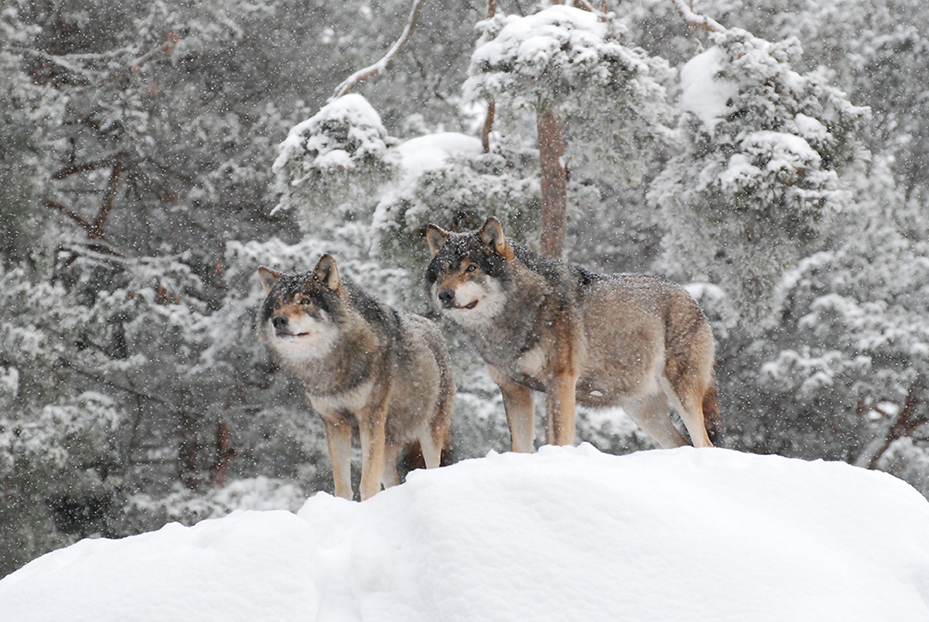- Home
- News and events
- Find news
- History holds clues to the future distribution of species
History holds clues to the future distribution of species

Wolves (Canis lupus) are mainly distributed in the colder areas of Europe and North America. Photograph: Mats Höggren, Nordens Ark.
Species range shifts in mammals must be analysed in light of both global warming and human activity. This is the conclusion of the researchers behind a new study published in Nature Climate Change that investigates the distribution of mammalian species in North America.
“We saw that it is impossible to fully estimate the effects of global warming on large mammals in North America without taking into account the human activity that affects the species,” says Sören Faurby of the University of Gothenburg.
Together with research colleague Miguel Araújo (Consejo Superior de Investigaciones Científicas (CSIC)) of the National Museum of Natural Sciences in Madrid, he has studied the historical effect of human activity on large mammals in North America.
“If we are to understand the current and future species range of mammals, we must study the past,” says researcher Miguel Araújo.
Well-documented species
According to the researchers, studying large mammals on the North American continent is ideal, as the distribution and dispersal ability of these species is well understood.
For example, the grey wolf (Canis lupus) was once widespread across warmer areas of North America. However, the wolf has now retreated from many of these areas due to humans.
“We must draw attention to the fact that the current distribution of species is decided by both climate and human activity, and that we need to incorporate historical species range into assessments if we are to understand the actual climate tolerance of a species,” explains Sören Faurby.
Species forced back
Although information about historical species range is not as well documented for other locations as it is for North America, researchers believe that the process of reduced distribution due to human activity may well follow a similar pattern.
 “For example, this applies to species that are found on several continents, such as wolves or brown bears, both of which are native to both North America and Europe,” says Sören Faurby.
“For example, this applies to species that are found on several continents, such as wolves or brown bears, both of which are native to both North America and Europe,” says Sören Faurby.
In North America, brown bears were once found across California and down into northern Mexico. Now however, they have been driven further north, with their current southern limit being in Yellowstone close to the Canadian border.
Brown bears were once also more widespread across Europe.
“A slow decline set in several thousand years ago, when brown bears disappeared from Denmark, a country lacking the mountain ranges or extensive forests that the European brown bear now inhabits,” says Sören Faurby.
Impact from many directions
At the same time, researchers point out that the results should not be over generalised.
“Our study highlights the fact that the central effects of global warming (i.e. increased temperatures and potential changes to precipitation) can be overstated when estimating the future distribution of species, but we emphasise that several other factors are not included in the models,” says Sören Faurby.
The presence and survival of various mammalian species appears to be dependent on a variety of factors, such as interactions between climate change, changes in land usage and the fragmentation of habitats.
“There may also be other factors, such as the spread of disease and invasive species, that are not generally reported in forecasts for future global changes to biodiversity,” says Miguel Araújo.
Title: Anthropogenic range contractions bias species climate-change forecasts
Link:
http://rdcu.be/HQnq
Contact:
Sören Faurby, researcher at the Department of Biological and Environmental Sciences, University of Gothenburg, telephone: +46 (0)73 642 24 82, e-mail: soren.faurby@bioenv.gu.se
Photograph (top picture):
Wolves (Canis lupus) are mainly distributed in the colder areas of Europe and North America. They were once more common in warmer areas but have been eradicated from most of these as a result of competition from humans. Models that investigate the distribution of wolves based solely on climate change will therefore provide an incomplete picture of the wolf’s ability to withstand climate change. (Photograph: Mats Höggren, Nordens Ark)
Portrait of Sören Faurby.
Figure:
Results from the new study showing prognoses for the number of large mammals in North America in 2070, in a scenario with massive climate change based solely on current observations (Current observations) and a scenario based on both current and historical observations (All observations). The different colours represent different numbers of species within each area. The areas in which less species are predicted are shown in blue. The areas where most species are predicted are shown in red.
(Illustration: Sören Faurby)